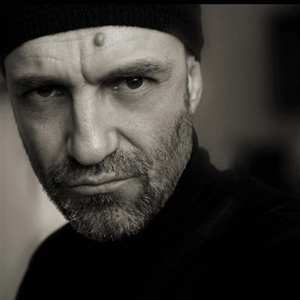MIKEL TEMO
Faces of uncertain time
May 29 > June 17, 2023

Munch’s iconic paintings, in addition to its unique plastic values, created the most vocal painting of despair, sadness, anxiety and melancholy in the world art. He stylistically influenced the German Expressionists, as well as the two great Austrian painters, Oskar Kokoschka and Egon Schiele.
The message of sadness, despair, existential anxiety unites the painting of Edvard Münch with the self-portraits’ cycle of Mikel Temo. They are separated by style, but united by a common message. The deepest penetration into the loneliness and fear zone, the melancholy that is given with the voice, is the expression of human anxiety. The immense scream is a reflex of a deep crisis, of a repressive, oppressive feeling. Mikel Temo’s self-portraits tense to the maximum; with extreme gesticulations, they want to let out a scream. His distorted portraits address themselves more as an act of self-liberation, than a transmission of pain. They unleash an indescribable horror. His gestures disgust.
All the anatomical elements of extreme and confused mimicry give concrete forms to anxiety, crisis, pain, despair and existential loneliness.
In his self-portraits, Mikel Temo does not cover the pain with make-up. He distorts reality to highlight the situation. It would be disingenuous for artists to see only the bright side of life. Mikel Temo does what the expressionists did, making the human sufferings directly as subject of depression, melancholy, revolt, poverty, violence, anger; he tends to see reality honestly. He himself becomes the mirror of this range of forms, putting the self-portrait at the center of this cycle.It is, undoubtedly, a sudden and successful flow in modern Albanian painting.”
MEET THE ARTIST

Mikel Temo (1962) painter, sculptor, graphic artist, painting teacher and Director of the Monumental Painting Program at the University of Arts in Tirana, holds the title “Doctor of Science” in the field of Art Psychology. Since October 1998, he has divided his life among three countries: France, Canada and Albania. He remains one of the most contemporary artists, passionate of figurative and abstract research and discoveries, not only in terms of language, plastic tools, morphology, but also the syntax of the image and forms of art presentation.
Mikel Temo (1962) piktor, skulptor, grafist dhe pedagog i pikturës dhe Drejtues i Programit të Pikturës Monumentale në Universitetin e Arteve në Tiranë, ai është mbartës i titullit Doktor i Shkencave në fushën e Psikologjisë së artit. Nga tetori i vitit 1998 ai ka ndarë jetën mes Francës, Kanadasë dhe Shqipërisë, mbetet një nga artistët bashkëkohorë të pasionuar pas kërkimesh dhe gjetjesh të befta figurative dhe abstrakte, qoftë për sa i përket gjuhës, mjeteve plastike, morfologjisë, por dhe sintaksës së imazhit dhe formave të paraqitjes së artit.
